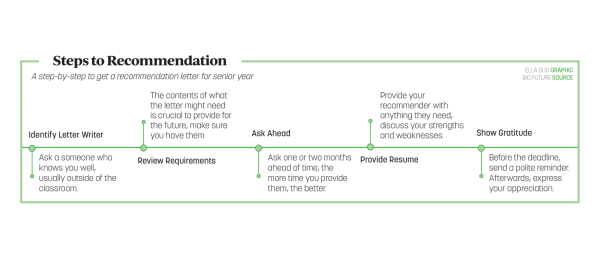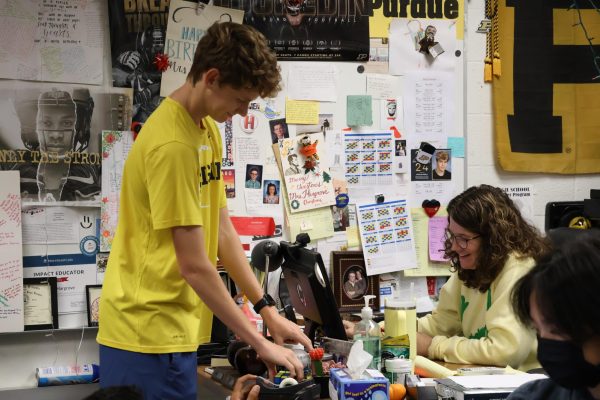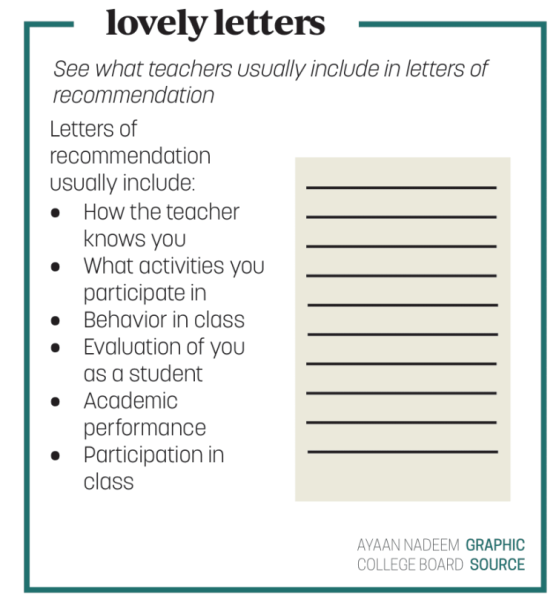Junior Allison Shen is far from alone in believing recommendation letters are an important part of the college admissions process. According to a 2023 survey by the National Association for College Admission Counseling, 75% of students reported teacher recommendations as somewhat or very important in the college application process. The survey reports recommendation letters are perceived as important as often as a student’s writing sample and just below admission test scores. As a result, there is a significant incentive for students to build relationships with their teachers.
“Recommendation letters definitely have encouraged me to get to know my teachers on a deeper level,” Shen said. “I have felt another reason to form deeper connections with teachers, rather than just enjoying being in their class.”
Senior Sam Winiger said he agreed with Shen, especially in cases where students are trying to maximize their college admission chances in high school.
“If you are thinking about that and planning ahead for college in your freshman or sophomore year, recommendation letters can provide you an incentive to do well in your classes and make sure your teacher knows you in junior year,” Winiger said. “After all, it’s pretty difficult for a teacher to write a recommendation letter if you aren’t participating in class and putting yourself out there.”
However, Shen said recommendation letters, although helpful, could be stressful.

“There are so many great teachers out there, and many times it can feel hard for me to feel like any teacher will have enough to say about me since I can at maximum only see a teacher for around two to three blocks each week,” Shen said. “However, when I do attempt to form more connections, I do come to appreciate those moments with a teacher because they do have a lot to share, and some things just can’t be covered fully just by being in a class.”
To Winiger, stress can even be present before and after the school year of the class a student is getting a recommendation from.
“I think it’s definitely stressful (for students),” Winiger said. “I think it’s also stressful during senior year when you have to ask for rec letters. For example, some teachers want you to send them a resume, and I didn’t have that which was another source of stress. I can also see how it might be stressful if you come into a class on the first day with the idea of getting a good rec letter a year in the future and trying to stand out.”
Although she does believe recommendation letters are stressful, Shen says that planning for the future can help reduce stress.
“I do have an idea on (a teacher), but since I’m in (my) junior year, I’m still looking forward to getting to know the teachers I have this year more,” Shen said. “Knowing at least one helps take some burden off of my thinking about college applications as it is a major part of the process, but I feel like it also allows me to gear any future opportunities I have related to college applications towards those teachers.”

(Evelyn Foster)
In addition, while recommendation letters can be a source of stress for students, they are one of the few portions of the college application that require the work of someone other than the student. Unfortunately, this means that the time put into recommendation letters often comes at the expense of teachers.
“I’ve heard of teachers having in excess of 20 or 30 recommendation letters,” physics teacher David James said. “That would give me a lot of stress and eat into my planning time. The amount that I get is very manageable and it is really fun reading through those brag sheets that the counseling department has kids fill out. It’s neat to see all the things that we don’t have time to talk about. The writing part, it gets a bit repetitive. Everybody who asks is a good kid, everybody who asks works hard, and trying to make it unique for every recommendation letter gets tough. So your writer’s voice gets repeated as you’re trying to make it unique, which I think is the challenge.”
Winiger said from his perspective, he can understand how recommendation letters can stack up if teachers accept every request they receive.
“It can be a big problem,” Winiger said. “I think it can be stressful for them, but at the same time, they’re accepting (writing) letters so they know the responsibility. They don’t accept everybody that asks them, so they know how many they have to write. I think they will probably choose an amount they can comfortably write.”
On the other hand, for social studies teacher Alison Hargrove, who generally writes 100 recommendation letters a year, a request for a letter is considered an honor.
“It’s actually an honor because I teach so many academically gifted students,” Hargrove said. “I feel like it’s something that they’ve earned and therefore if I get them in class for a year the least I have to do on my end is write them a letter, then I feel like it’s a privilege.

Hargrove said although letters can take many hours, she does not regret writing the amount she does.
“It’s one of the biggest time commitments in my job,” Hargrove said. “I generally take about, depending on the student and depending on the letter, 30 minutes to about an hour per student. But again, it’s something that I enjoy. I’ll never feel stressed or overwhelmed when I get to brag about my students. That’s one of my favorite parts of my job.”
Regardless of the quantity of letter requests, James said the quality of the letters doesn’t change much at all for most teachers.
“I think for me that the quality of my letter doesn’t change based on the number because I’m only going to say yes to the point that I can actually do them authentically for each student,” James said. “If I had 40 to do, I think it might just be a form letter that gets chugged out. Like, if you’re a good kid, you get this one. You were in AP Physics C, you get this letter. For the amount I have, I can actually spend time on each one. It’s definitely something I have to plan out. Everyone wants it done by Nov. 1. So, I give August for everyone to get on my list. I have September and October to get those done. I try to get a couple done a week to keep it manageable. I feel like the quality stays about the same.”
Language arts teacher Tony Dunham, who said he writes approximately 20 to 30 recommendation letters a year, said he agreed about not accepting recommendation requests unless he could guarantee their quality.
“I really try to write solid recommendations for any students that I agree to write a recommendation for,” Dunham said. “I won’t agree to write one if I don’t think I can honestly recommend them in good conscience. That being said, those students usually are student leaders who volunteer outside of the school and are involved in the community. They typically performed well in my class while also exhibiting those ‘soft skills’ —participating in discussions, meeting deadlines, working with others, etc.— that show they are ready for college.”

Despite their place in most college applications, James said he questioned if the stress around recommendation letters is even warranted when schools receive so many recommendation letters every year.
“I wonder about the content of my recommendation letter mattering because when they’re getting thousands of files to admit students or not admit students, how closely are they reading those letters?” James said. “I try to make them unique for the student but in the end, maybe it’s me being cynical, is the admissions group just saying, ‘Do they have letters from teachers that recommend them?’ and then they check the boxes or are they reading the letters? I don’t know, I would love to have a conversation with an admission person from Purdue or IU or Butler just to get the big school and small school stance on the content of the letters.”
Dunham said he had a similar stance, highlighting that large schools may not even get to reading every recommendation letter sent to them.
“I don’t love putting a lot of time and effort into a letter that is just being sent to a large school like IU or Purdue, where they are unlikely to be actually read by the admissions team.”
All in all, Dunham said he hopes students realize how much work recommendation letters are.
“I think that they can definitely be positive when students recognize how much time and effort they take,” Dunham said. “It’s extra unpaid hours in the fall (the busiest part of the year) when teachers are trying to focus on their new students. As long as students and the admissions office actually needs and will read them, I’m happy to try to help students reach their college admissions goals.”


